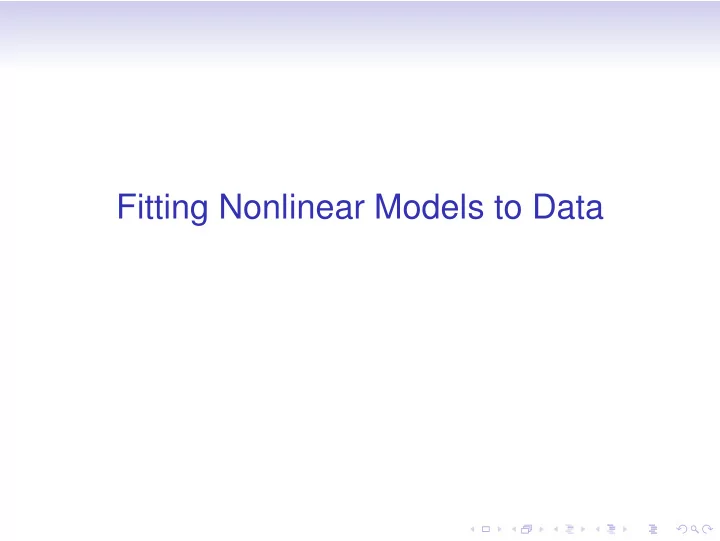

Fitting Nonlinear Models to Data
SI Model • The SI model we discussed before is often written dS / dt = − pS I d I / dt = pS I where S is the “susceptible” population – those at risk to become infected at a given time – and I is the infectious population. For this model the sum S + I remains constant over time; we called the sum N and substituted S = N − I in the second equation. • The resulting solution was N I ( 0 ) I ( t ) = I ( 0 ) + [ N − I ( 0 )] e − pNt
SIR Model • The SIR model (Kermack & McKendrick, 1927) is dS / dt = − pS I d I / dt = pS I − r I dR / dt = r I where R (for “recovered” or “removed”) is the number of people who were infected but are no longer infectuous. In this case, I + R is the cumulative number of people infected. • One can add a term to the first equation representing new arrivals to the susceptible population. • There is no formula for the solutions.
Properties of Solution Families • Each model’s family of solutions has some properties that are useful for fitting parameters to data. • A time-shifted solution is also a solution: If I ( t ) is a solution, then I ( t + c ) is also a solution (with a different initial condition). This is because the model is “autonomous” – no explicit t dependence. • A rescaled solution is also a solution: If I ( t ) is a solution, then a I ( bt ) is a solution of the same model with different parameters. • Given a data set and the graph of a solution I ( t ) , we can try to shift and rescale the graph to fit the data.
Change of parameters for SI model solution • We can rewrite N I ( t ) = 1 + [ N / I ( 0 ) − 1 ] e − pNt N = 1 + e − λ ( t − δ ) = Ng ( λ ( t − δ )) where λ = pN δ = log [ N / I ( 0 ) − 1 ] /λ g ( x ) = 1 / ( 1 + e − x ) .
Interpretation of new parameters • If we find parameters N , λ, δ that fit the data, we can solve for the original parameters p and I ( 0 ) . However, the new parameters may be more interesting in their own right. • N is the total number of people who will be infected over the outbreak, according to the model. • δ is the time at which N / 2 people have been infected, and at which d I / dt peaks; it is more relevant than I ( 0 ) to the data and to the intepretation of the model. • λ is the rate at which the outbreak unfolds; it represents the rate per unit time a single person is infecting others early in the outbreak.
Data Fitting Problems • Given data points [ t j , I j ] , where I j is an estimate of the cumulative number of people infected at time t j , we can try to minimize the sum of squared residuals J � [ I j − Ng ( λ ( t j − δ ))] 2 . E I ( N , λ, δ ) = j = 1 • If the data is [ t j , y j ] where t j = j and y j is the number of new diagnoses per unit time, then we can fit d I / dt to the data by minimizing J � [ y j − N λ g ′ ( λ ( t j − δ ))] 2 . E y ( N , λ, δ ) = j = 1
Partial Solution • We have posed nonlinear least squares problems. • Numerical methods for optimization can yield approximate minimizers N , λ, δ . • We can make some progress algebraically, since E is a quadratic function of N . Minimizing E I over N yields J � J � � [ g ( λ ( t j − δ ))] 2 . N λ,δ = I j g ( λ ( t j − δ )) j = 1 j = 1 • Substituting and simplifying yields J J � � I 2 E I ( N λ,δ , λ, δ ) = j − N λ,δ I j g ( λ ( t j − δ )) . j = 1 j = 1
Simple Approaches to Minimizing E • Fix one parameter (say δ ) and compute E ( N λ,δ , λ, δ ) for various λ ; look for the value of λ that minimizes E for the chosen value of δ . Then fix λ and adjust δ to make E as small as you can. Then go back and see if you can make E smaller by adjusting λ , etc. • Make a contour plot of E ( N λ,δ , λ, δ ) over a range of plausible λ and δ values. Zoom in near the apparent minimum and make another contour plot, etc. • These approaches can be automated, and of course there are more sophisticated approaches; the latter become important when there are more parameters and/or when the function to be minimized takes a very long time to compute.
Recommend
More recommend